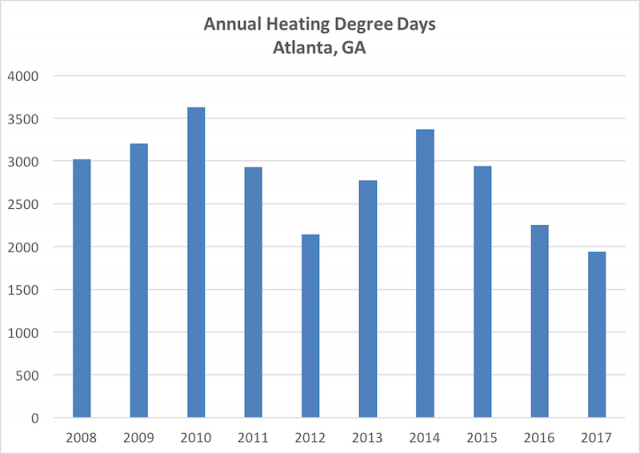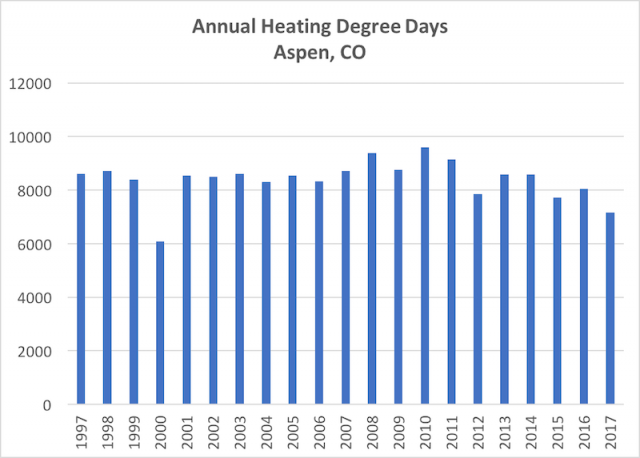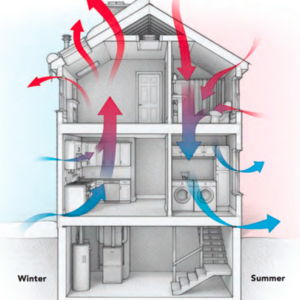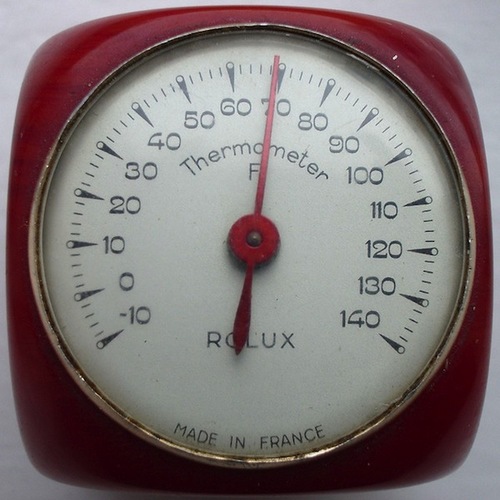
Image Credit: Image #1: Energy Vanguard. Two bar graphs were created by Energy Vanguard using data from Weather Underground
We’ve had some beautiful cool weather here in Atlanta this spring. It’s about 50°F outdoors as I write this, one week into the month of May. The high yesterday was only about 70°F.
We’re getting a few more heating degree days (HDD) in the middle of May. (Heating degree days are really just another way at looking at temperature, which I explained in more detail in a look at the fundamentals of degree days.) We occasionally pick up some HDD even in July and August. But it’s the winter HDD that matter for heating — and that give us a clue about the climate.
Below is a graph showing the heating degree days for Atlanta over the past ten years.
Our average number of heating degree days is about 3,000. This year, at less than 2,000, we’re at about two-thirds our average. Since the polar vortex of 2014 (remember that?), we’ve been down every year.
It’s not just us either. This was a banner year for snow out West. I got an email recently about a couple of ski resorts in the Sierra Nevada that will keep the lifts running into the summer. But the temperatures were higher this winter, and the heating degree days lower. Here’s a look at 21 years of heating degree days for Aspen.
Aspen’s long-term average is about 9,000 HDD. This year they got 7,165 through April. Now, weather ain’t climate, so you can’t look at one year or even two or three and draw long-term conclusions about climate. Since 2010, however, they sure have had a lot of mild winters in Aspen. That’s great for heating bills, not so great for skiing.
Of course, this has nothing to do with our atmosphere hitting the 400 parts per million level of carbon dioxide. Right? That climate change stuff is just a theory.
Allison Bailes of Decatur, Georgia, is a speaker, writer, building science consultant, and the author of the Energy Vanguard Blog. You can follow him on Twitter at @EnergyVanguard.
Weekly Newsletter
Get building science and energy efficiency advice, plus special offers, in your inbox.
















7 Comments
Heating degree days are going down; temperatures are going up
Allison,
Thanks for the snapshots of Atlanta and Aspen.
For a planet-wide perspective, it's worth checking out this graph of the global mean surface temperature. While heating degree days are dropping, surface temperatures are rising.
[Click on the image to enlarge it.]
.
Wrong Martin...
Trump is going to buy yiuge ice cubes from Shina and cool dawn da planet bigly...
Global warming might be GOOD for skiing in Aspen!
"Since 2010, however, they sure have had a lot of mild winters in Aspen. That's great for heating bills, not so great for skiing."
Skiing conditions aren't about HDD- it's all about the quantity & quality of frozen precipitation. Aspen is high enough and cold enough that even if they lost 1000 HDD (a greater than 2C rise in wintertime temps) the precipitation will still be snow. Warmer winter temps there means fewer bitter cold mornings when it's too cold to go skiing.
As a general rule global warming will also be increasing levels of atmospheric moisture and average precipitation- those are GOOD things for skiing in Aspen. Being smack in the middle of the continent Aspen gets a lot less moisture than the (aptly named) Sierra Nevada, since the adiabatic cooling causes the moist Pacific air to dump the larger fraction of the moisture load there before moving east. Unless prevailing upper level winds shift to coming straight out of the arctic, average snowfalls in Aspen are more likely to increase with global warming, and the number of more comfortable skiing temperatures may increase as well. With a deeper winter snowpack, the spring skiing season is likely to be extended.
Variations in regional snowfall in the Sierra Nevada and elsewhere related to the El Niño and La Niña phenomena are well known. The improvement in skiing conditions clearly won't be uniform across all skiing areas, and there will still be better years than others, but for higher altitude ski areas the predictions are for higher average precip, even as the warmer summers are shrinking glaciers and permanent snowfields at an accelerating rate.
The skiing losers in global warming will be the already marginal low-altitude hills, where a 2C rise in average winter temps makes mid-winter wash-outs of heavy liquid precipitation more common, such as my local hill. This is what the spring "skiing" was like at ~1500' of elevation as of last Thursday:
https://vimeo.com/218017115
There's clearly more than that left at Aspen right now (but it looks like a longer hike to snow than at the local hill :-) ) :
http://aspenwebcam.com/live-webcams/aspen-mountain-ajax
Thanks for the thrilling video
It's great to capture these exciting sports moments with a head-mounted camera. My heart was in my throat as I watched your daredevil descent.
Too hot to wear a helmet-cam
It was ~85F out on the hill @ 7PM when those clips were taken with a hand held still camera operated in video mode (which only enhances the arm waving excitement! :-) )
A few more heating degree days later...
Four days later (and ~2000' of elevation higher) these guys got some perhaps more compelling post-season footage:
https://www.youtube.com/watch?v=P9EwIXGAcDk&feature=youtu.be
Aspen skiing
Dana, yes, in comparison to skiing areas that lower than Aspen's 8-12 thousand feet of elevation, Aspen's going to do OK. I made it to Aspen this year and in early January we had a day where the skiing wasn't very good because it was raining in town and a wet, slushy snow on the mountains. I did two runs and gave up that day.
I monitored the temperatures the rest of January and February on my weather app and saw a lot of days where the daytime highs went into the 40s and even 50s. That melts the surface snow during the day and it refreezes at night, making for a hard, crusty surface the next morning until it melts again.
But it never got as icy as your lump...uh, I mean, local hill... did in that video you shared.
North Carolina, where I've skied a couple of times, is definitely one of the losers. With slopes from 4,100' to 5,300', it's not very high. They make most of their snow, but that's getting harder to do with warmer temperatures.
Log in or create an account to post a comment.
Sign up Log in